| Editorial leads: | Chris Gorski and Laura Howes |
| Project manager: | Michael Sheehan |
| Writers: | Chris Gorski, Laura Howes, and Benjamin Plackett |
| Creative director: | Robert Bryson |
| Art directors: | Robin L. Braverman and William A. Ludwig |
| UI/UX designers: | Seamus Murphy and Kay Youn |
| Web producers: | Luis A. Carrillo, Ty A. Finocchiaro, and Jennifer Muller |
| Copyeditor: | Sabrina J. Ashwell |
| Production editors: | Jonathan Forney, David Padgham, and Raadhia Patwary |
| Engagement editors: | Liam Conlon, Leeann Kirchner, and Marianna Limas |
Advertisement
Grab your lab coat. Let's get started
Welcome!
Welcome!
Create an account below to get 6 C&EN articles per month, receive newsletters and more - all free.
It seems this is your first time logging in online. Please enter the following information to continue.
As an ACS member you automatically get access to this site. All we need is few more details to create your reading experience.
Not you? Sign in with a different account.
Not you? Sign in with a different account.
ERROR 1
ERROR 1
ERROR 2
ERROR 2
ERROR 2
ERROR 2
ERROR 2
Password and Confirm password must match.
If you have an ACS member number, please enter it here so we can link this account to your membership. (optional)
ERROR 2
ACS values your privacy. By submitting your information, you are gaining access to C&EN and subscribing to our weekly newsletter. We use the information you provide to make your reading experience better, and we will never sell your data to third party members.
People
Scenes from where chemists work
C&EN readers share images of the laboratories where they work and what makes those spaces special to them
by Laura Howes
September 2, 2023
| A version of this story appeared in
Volume 101, Issue 32

Credit:
by Laura Howes
September 29, 2023 | A version of this story appeared in Volume 101, Issue 32
What makes a laboratory special? Is it the people who do the work, the architecture and location, or something more intangible? In August, C&EN sent out a call to see inside readers’ labs. Many chemists responded. These are a selection of the snapshots that our readers sent in. They show labs, lab mates, and locations from around the world.
PEOPLE
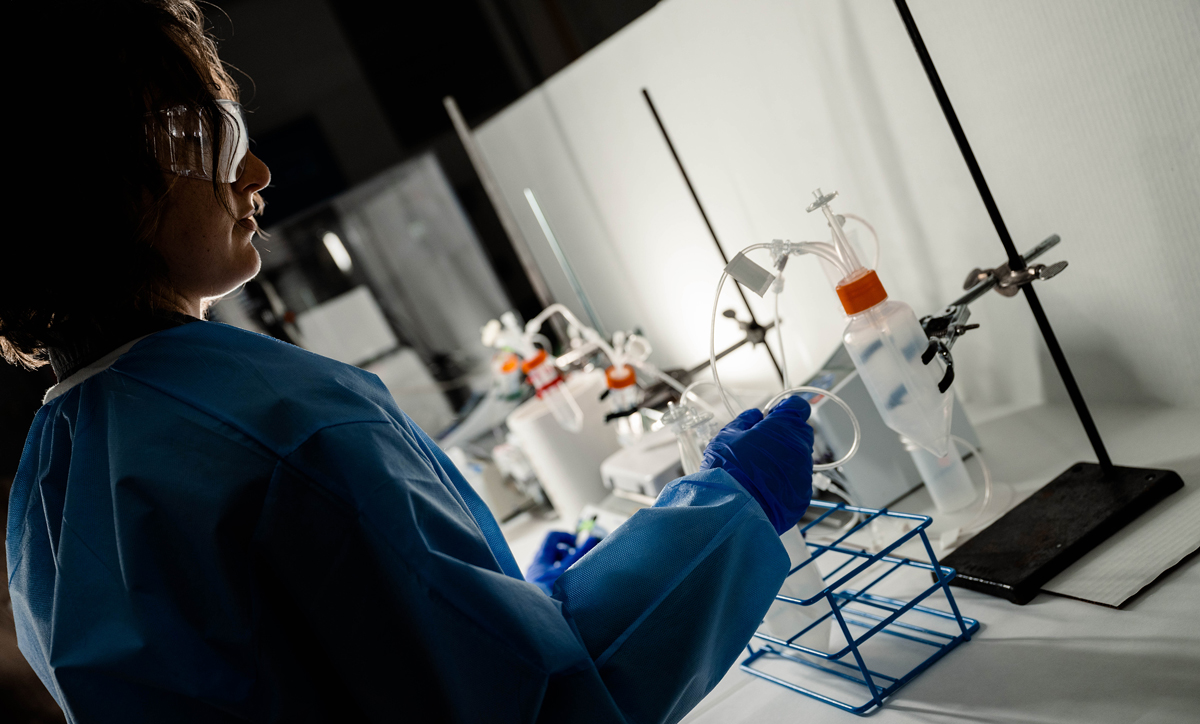
In the lab, you make things
Natalie Nold is preparing a continuous viral vector manufacturing line in Caryn Heldt’s bioseparation lab at Michigan Technological University. “Not only do we study viral biophysics and virus inactivation, we can also make vaccines and gene therapy vectors. But the most special part of the lab are the people who work there,” Heldt writes.
Credit: Sarah Atkinson/Michigan Technological University
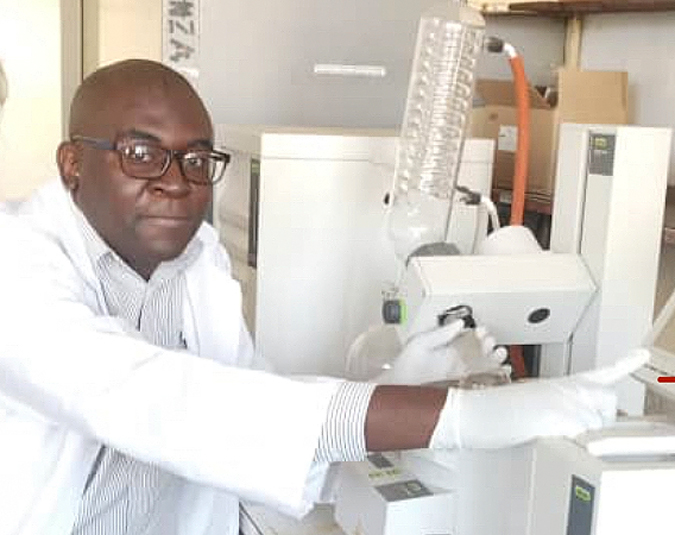
You keep one another safe
Yousef Fathisola (left) and Muhammad Nazrul Islam (right) test an eye wash and safety station. “The Polymer and Nano Engineering Laboratory (PolyNEL) at the University of Arkansas is very special to us,” says Kayla Foley, a postdoctoral researcher. “We are a unique and diverse group of researchers ranging from seasoned postdoctoral researchers to undergraduate students who have only just begun their journey into research.”
Credit: Kayla Foley
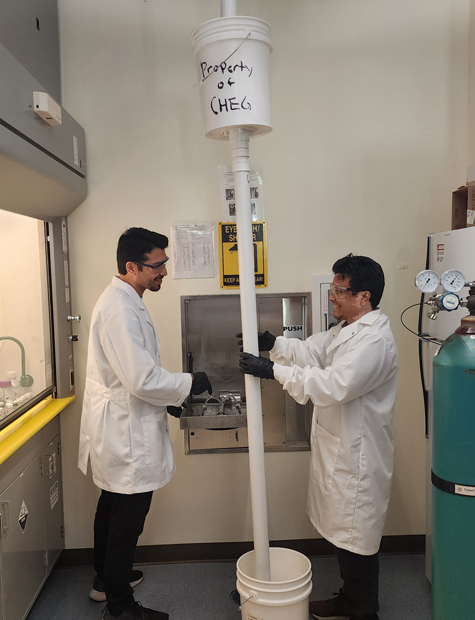
You remove solvents
Harrison Banda sent in this photo of himself in the organic synthesis and drug discovery laboratory at the University of Zambia.
Credit: Harrison Banda
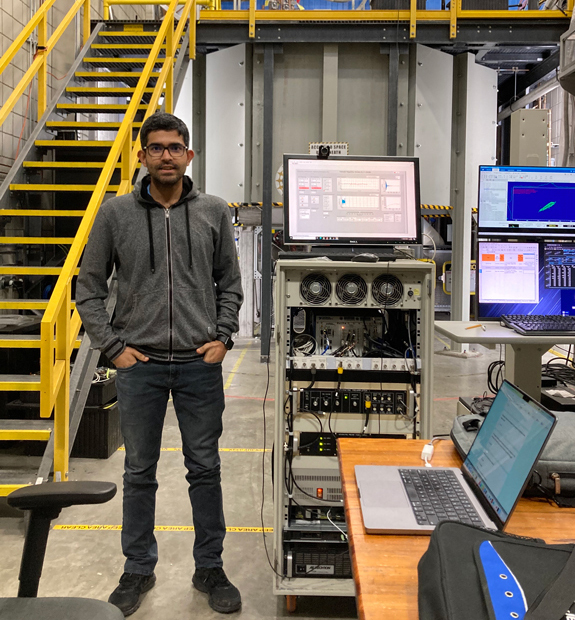
You give interviews
Thiago de Melo Lima sits in his lab at the Fluminense Federal University for an interview with local media. He writes that the lab and this institution are very special because they have become “my second house since 2018, when I became an associate professor.”
Credit: Thiago de Melo Lima
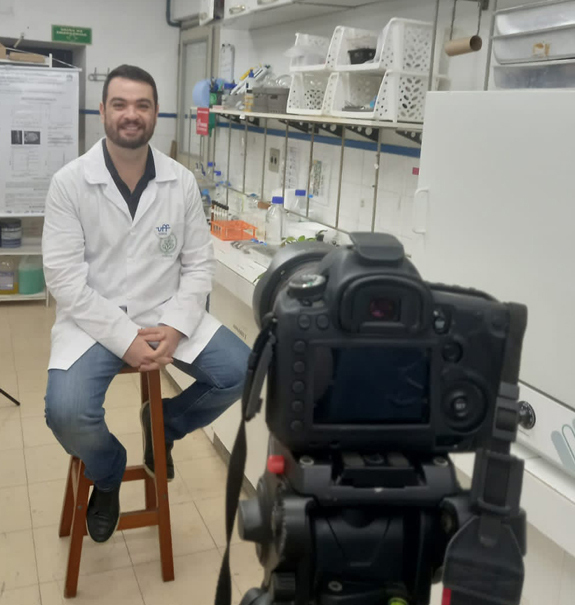
You use huge magnets
Most nuclear magnetic resonance experiments today are performed at magnetic fields of 9.4–18.8 T, but at the National High Magnetic Field Laboratory at Tallahassee, Florida, Amrit Venkatesh stands in front of a 36 T magnet. “I develop NMR applications using the 36 T series-connected-hybrid magnet, which is currently the highest magnetic field at which NMR is performed!” he writes.
Credit: Zhehong Gan

You learn about precision
At Palm Beach Atlantic University, nursing students compare the precision of three graduated cylinders in chemistry lecturer Gregory Rummo’s class.
Credit: Gregory Rummo
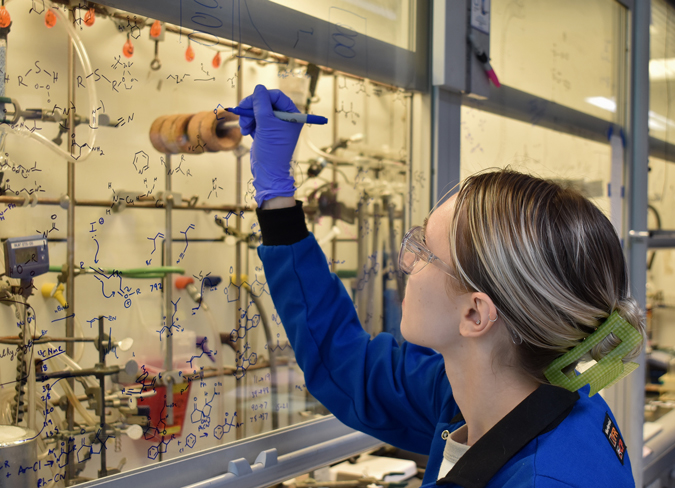
You perform analyses
This is an ultraviolet spectrometer lab at the Indian Institute of Technology Ropar.
Credit: Km Kirti

There’s always someone drawing on a fume hood
Students are hard at work at their fume hoods in Brian M. Stoltz's organic chemistry lab at the California Institute of Technology. “Our lab is special because it includes a diverse group of young scientists from across the globe that are excited to conduct cutting edge research in organic synthesis and methodology,” writes graduate student Marva Tariq, who submitted this image.
Credit: Sydney Bottcher

You pursue sustainable alternatives
Ryen Frazier obtains dissolving pulp from waste biomass for fiber spinning and textile applications at the Department of Forest Biomaterials of North Carolina State University’s College of Natural Resources. Frazier is part of the Sustainable and Alternative Fibers Initiative, a university-industry partnership focused on researching, developing, and using alternative fibers to manufacture a myriad of sustainable products.
Credit: Ryen Frazier

Students learn from experiments
Students at Ndiriti Aguthi Secondary School in Naro Moru, Kenya, do a kinetics lab. Colleen Kelley taught these students chemistry for a semester. She says, “At this school in rural Kenya, they had no electricity or water, and yet we were able to perform meaningful lab experiments with measurable outcomes using a flame heat source, glassware, and graph paper.”
Credit: Colleen Kelley
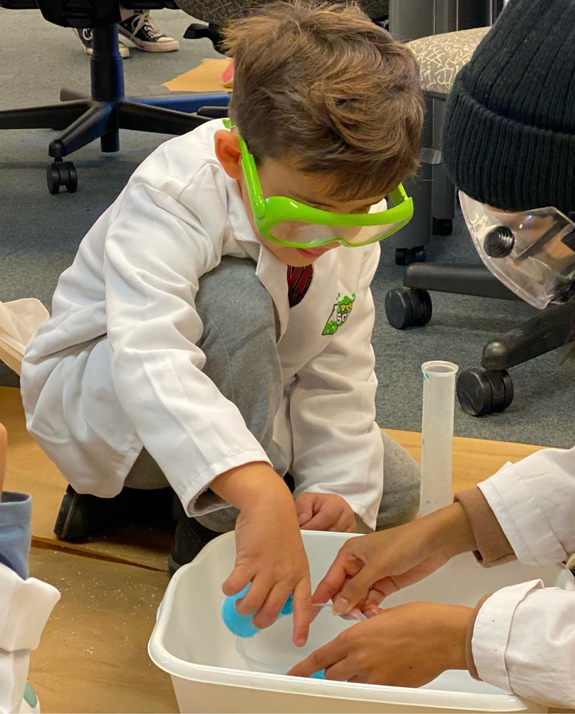
Young laboratory assistants get involved
A student at the Pierce College Child Development Center learns about hydrogels with the help of Los Angeles Pierce College organic students. This experience was part of a special collaboration at Pierce College between advanced chemistry students and some of the youngest scientists on the campus. The outreach event demonstrates that “science communication is an important skill worthy of a dedicated day to allow [the college students] to engage with the community as emerging leaders in science,” chemistry professor Cari D. Meyer says.
Credit: Pierce College Child Development Center
PLACES
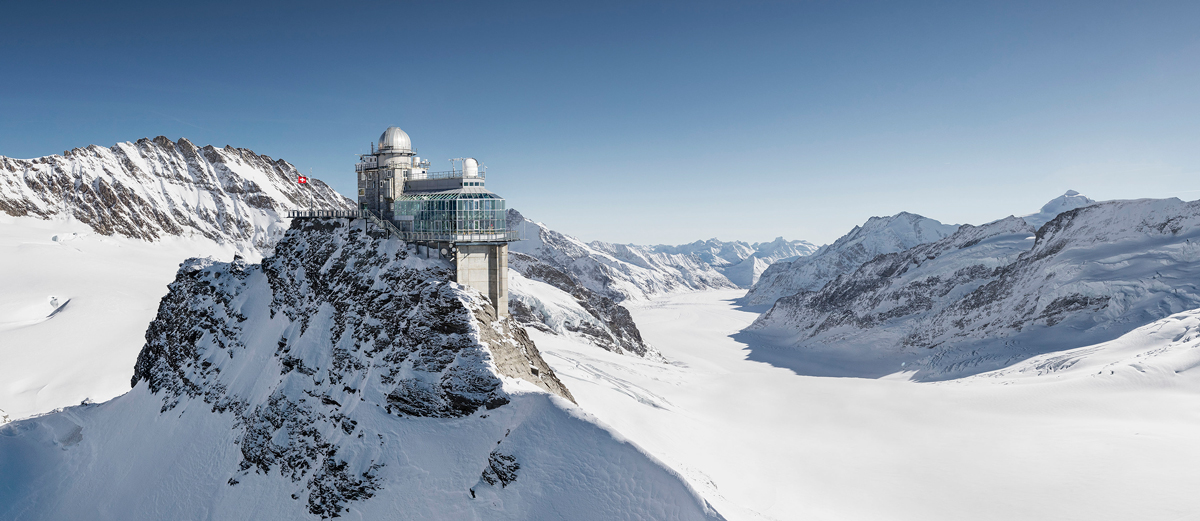
You work up in the mountains
The Sphinx Observatory at the Jungfraujoch in Switzerland is perched at 3,571 m above sea level. A part of the building contains the laboratories of the International Foundation High Altitude Research Stations Jungfraujoch and Gornergrat.
Credit: Jungfrau Railways
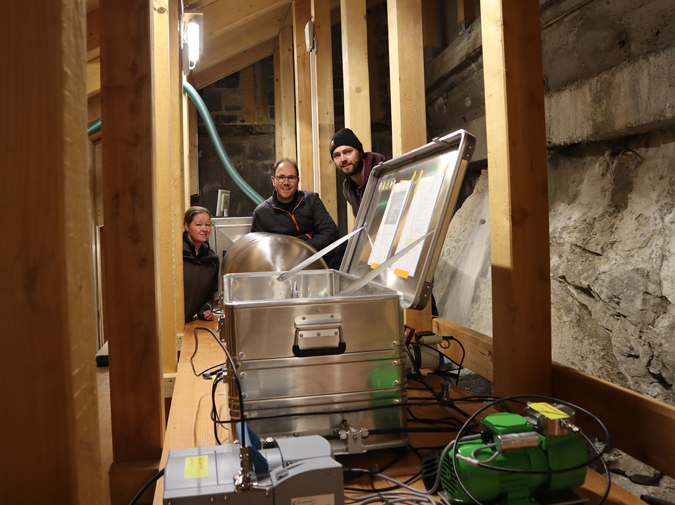
Sometimes there’s a beautiful view
Federico Bianchi of the University of Helsinki works on a time-of-flight mass spectrometer at the Jungfraujoch laboratory in Switzerland.
Credit: Federico Bianchi
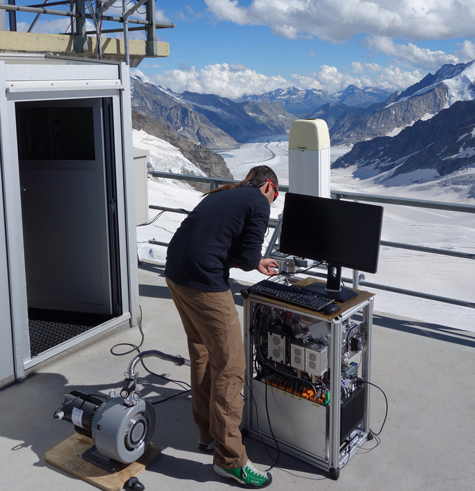
Sometimes the view is hidden
A novel air-sampling system was recently installed under the roof of the Jungfraujoch research station in Switzerland. It will allow the automatic sampling of air during the night. Every 2 weeks, the air sampled in this way is transferred into a bag and transported to the University of Bern for radiocarbon analyses of the captured methane and carbon dioxide.
Credit: Department for Chemistry, Biochemistry and Pharmacy/University of Bern
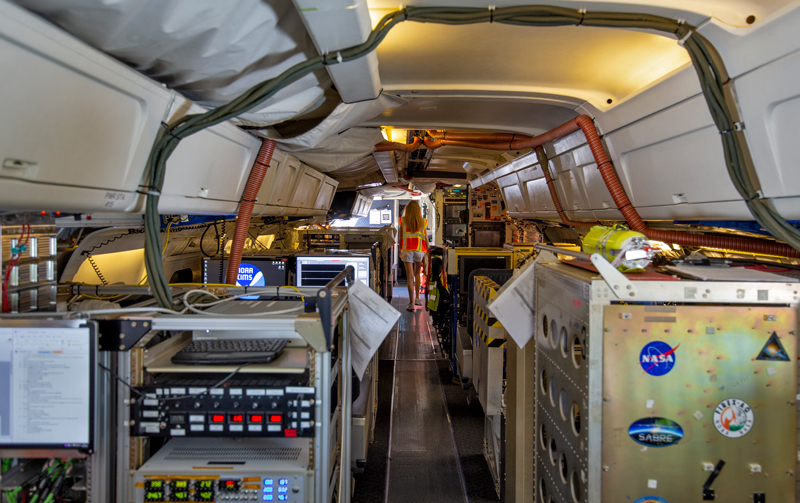
Some labs go up in the air
Atmospheric Emissions and Reactions Observed from Megacities to Marine Areas is a study led by the US National Oceanic and Atmospheric Administration's Chemical Sciences Laboratory to investigate air quality and climate across North America. As part of the project, the world's largest flying chemistry laboratory, NASA’s DC-8, was kitted out with a huge instrument payload to determine levels of volatile organic compounds, nitrogen oxides, carbon monoxide, carbon dioxide, and methane.
Credit: Monica Vazquez Gonzalez/NASA/Bay Area Environmental Research Institute
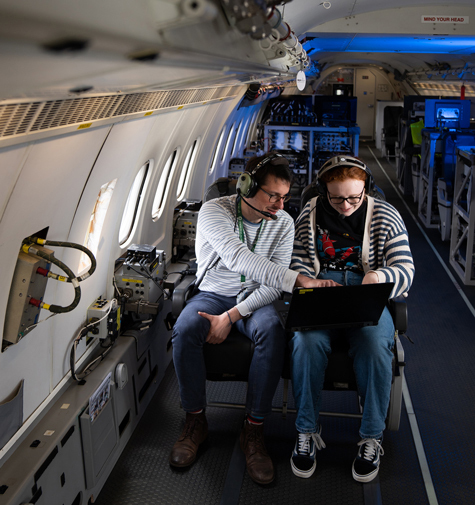
Other labs incorporate light and art
LabCentral, an incubator for life sciences and biotechnology start-ups, offers laboratory and office space for as many as 100 start-ups comprising approximately 1,000 scientists and entrepreneurs across its facilities. This photo from LabCentral 238 in Massachusetts shows the intersection of labs, colorful open space for community interaction, and the organization’s Gallery 1832 art exhibit—which features rotating art installations by local artists with diverse backgrounds and viewpoints.
Credit: Anton Grassl/Perkins&Will
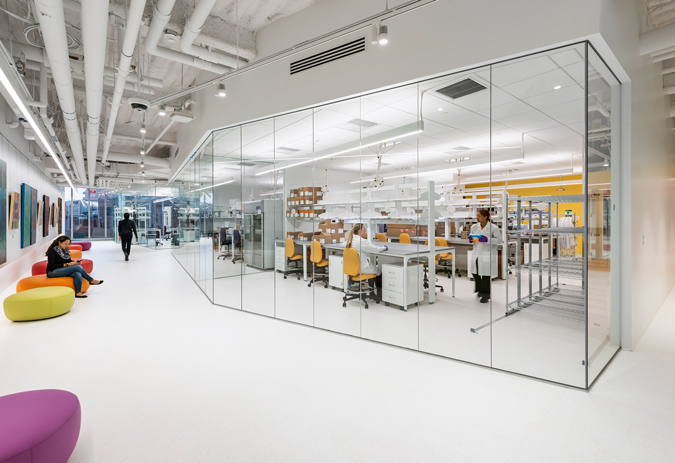
Sometimes chemists go up in the air too
Eve Grant (right) and Arthur Zielinski (left) work at one of the seat pairs on board the UK’s FAAM Airborne Laboratory—the largest of its kind in Europe. Aircraft Wi-Fi allows scientists to wirelessly monitor data from instruments using laptops. In-flight entertainment looks a little different on this modified BAe-146-301 research aircraft.
Credit: National Centre for Atmospheric Science

There are always sunsets
A poly(ethylene oxide)-modified polydimethylsiloxane sample produced by Oluwatobi Ojuade is juxtaposed against the sunset observed from the Hsiao lab at North Carolina State University.
Credit: Pedro Henrique Wink Reis

And there are always stars in the sky
The Pyramid International Laboratory/Observatory is a high-altitude scientific research center in Nepal. Located at just over 5,000 m above sea level, it is close to the Everest base camp and is fully covered by solar panels because there are no other energy sources. Federico Bianchi of the University of Helsinki visits the observatory along with other stunning locations as part of his atmospheric research.
Credit: Federico Bianchi
PERSONALIZATION

Keep your googly eyes peeled
The Australian Synchrotron is the only synchrotron facility in Australia and has thousands of research visits a year. Scientists head to the facility to use the equipment for sample analysis. Eleanor Campbell, who works there, says staff have started a trend of decorating the user cabins at the facility, and some googly eyes have also appeared on the new sample-handling robot. “She will grab crystals from a large tank of liquid nitrogen and place them in the path of our X-Ray beam for analysis,” Campbell writes. “Her yellow colour looks great against the pale blue radiation shielding!”
Credit: Eleanor Campbell
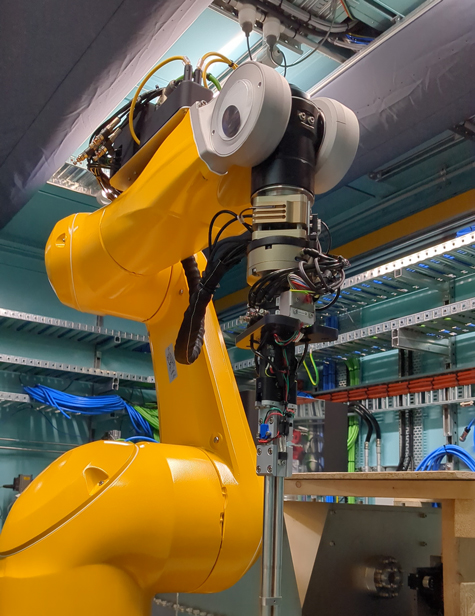
Tie your hair back
During the pandemic, facilities management at Northwestern University provided chemists with a dutch door to help ensure social distancing. Knowing that restrained hair is a good idea in the laboratory, Michael Blayney of the Research Safety Office placed a jar of hair ties on the shelf. “Two and one-half years (and hundreds of hair ties) later, this simple offering has become a fascinating study of human behavior,” he says. “While colors vary from batch to batch, it is remarkable how our scientists carefully sort through the jar to find just the color or two they want. Lowering the barriers to health and safety helps to ensure that the desired behaviors are realized. And it may only take a hair tie or two to effectuate positive change.”
Credit: Michael Blayney
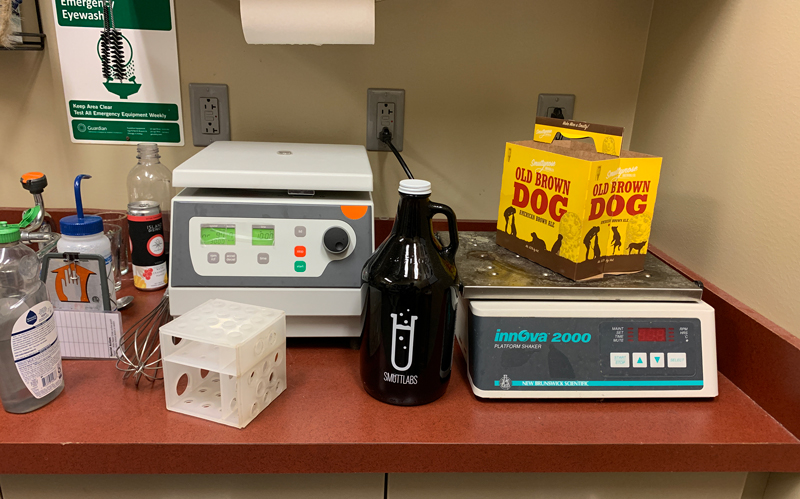
Can you spot something different?
When C&EN reporter Craig Bettenhausen traveled to Smuttynose Brewing earlier this year, he was struck by the cans of beer among the chemistry equipment in the lab. Smuttynose was one of the early craft breweries to have its own dedicated lab space and staff as opposed to relying on contract research labs and yeast providers. Now many small and midsize operations have those things. The change has made for better beer and has led to a large increase in brewing-science jobs, he says.
Credit: Craig Bettenhausen/C&EN
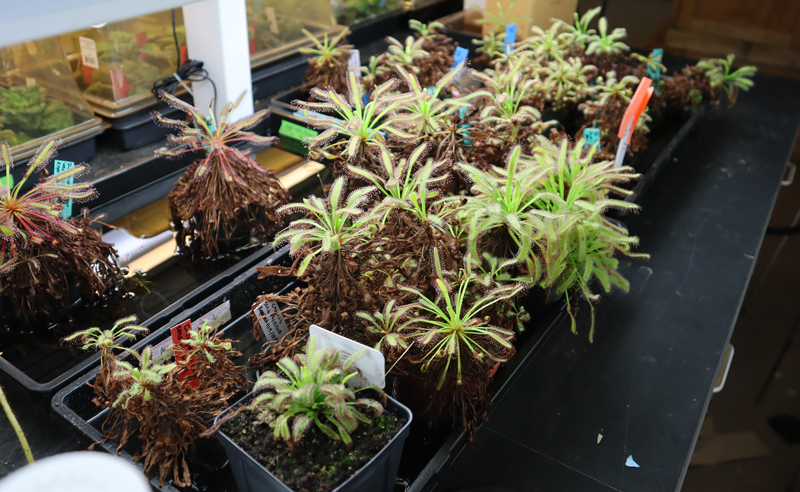
Some labs have live plants
Sitting on a bench is a tray of Drosera capensis (Cape sundew), whose genome was sequenced by Rachel Martin’s lab at the University of California, Irvine. “What makes the Martin lab special is the incredible variety of projects we work on, and the accompanying expansive list of techniques we use to do so,” graduate student Zane G. Long says. “Both graduate students and undergraduate researchers in the lab master a variety of techniques to advance their projects, including [nuclear magnetic resonance] spectroscopy, mass spectrometry, and many more.”
Credit: Zane G. Long
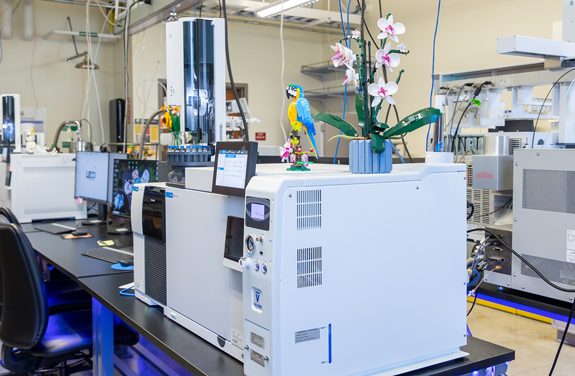
Some labs have lego plants
At the Complex Chemical Compositional Analysis Lab at California State University, Los Angeles, Lego mascots accompany challenging data processing sessions, says Petr Vozka, who runs the lab. The gas chromatography instruments are set up so that students can easily access the backs of the instruments and learn how to connect them and troubleshoot.
Credit: Victor Mojica
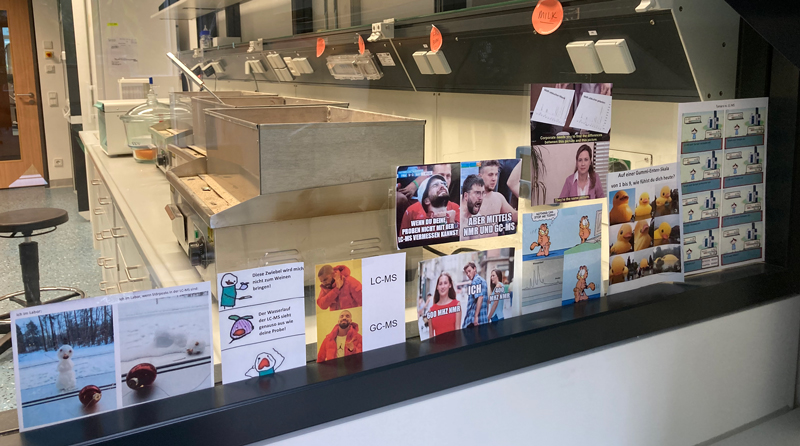
Memes get shared on windows
Chemists at the Friedrich Alexander University Erlangen-Nuremberg have started quite a collection of memes and jokes about their work analyzing foodstuffs.
Credit: Simon Hammann
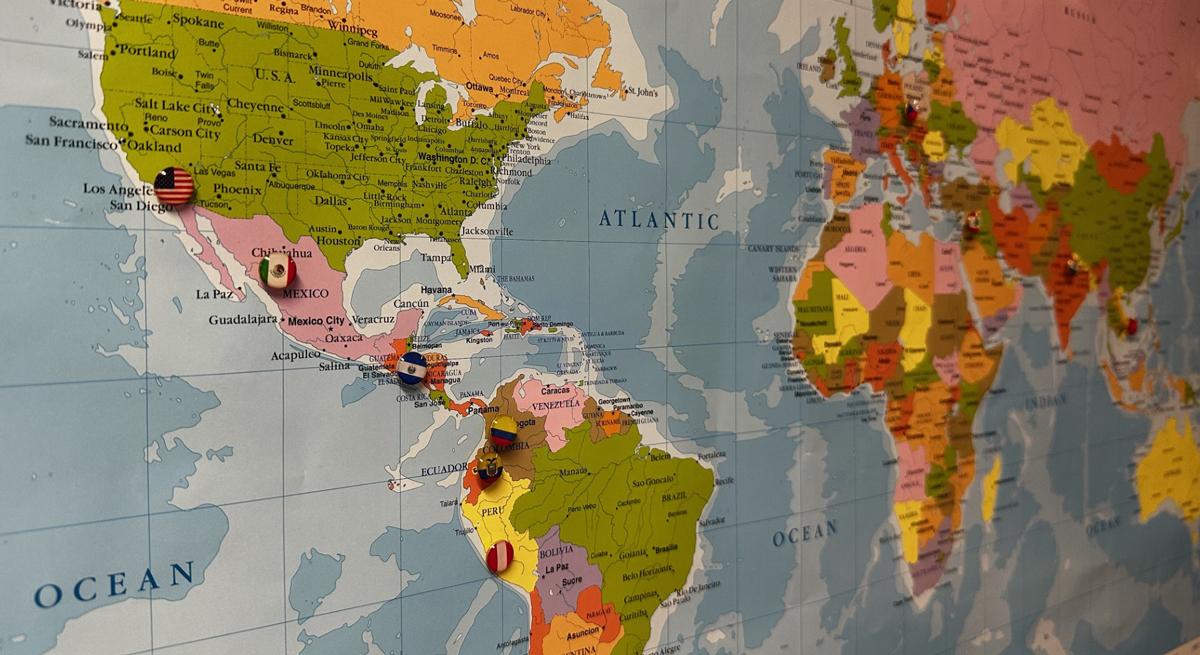
People always make their mark
“Our lab embraces diversity and heritage,” writes lab leader Petr Vozka at California State University, Los Angeles. “As each new student joins our ranks, they mark their hometown on our world map, weaving a vibrant tapestry of origins.”
Credit: Petr Vozka
PEOPLE

In the lab, you make things
Natalie Nold is preparing a continuous viral vector manufacturing line in Caryn Heldt’s bioseparation lab at Michigan Technological University. “Not only do we study viral biophysics and virus inactivation, we can also make vaccines and gene therapy vectors. But the most special part of the lab are the people who work there,” Heldt writes.
Credit: Sarah Atkinson/Michigan Technological University

You keep one another safe
Yousef Fathisola (left) and Muhammad Nazrul Islam (right) test an eye wash and safety station. “The Polymer and Nano Engineering Laboratory (PolyNEL) at the University of Arkansas is very special to us,” says Kayla Foley, a postdoctoral researcher. “We are a unique and diverse group of researchers ranging from seasoned postdoctoral researchers to undergraduate students who have only just begun their journey into research.”
Credit: Kayla Foley

You remove solvents
Harrison Banda sent in this photo of himself in the organic synthesis and drug discovery laboratory at the University of Zambia.
Credit: Harrison Banda

You give interviews
Thiago de Melo Lima sits in his lab at the Fluminense Federal University for an interview with local media. He writes that the lab and this institution are very special because they have become “my second house since 2018, when I became an associate professor.”
Credit: Thiago de Melo Lima

You use huge magnets
Most nuclear magnetic resonance experiments today are performed at magnetic fields of 9.4–18.8 T, but at the National High Magnetic Field Laboratory at Tallahassee, Florida, Amrit Venkatesh stands in front of a 36 T magnet. “I develop NMR applications using the 36 T series-connected-hybrid magnet, which is currently the highest magnetic field at which NMR is performed!” he writes.
Credit: Zhehong Gan

You learn about precision
At Palm Beach Atlantic University, nursing students compare the precision of three graduated cylinders in chemistry lecturer Gregory Rummo’s class.
Credit: Gregory Rummo

There’s always someone drawing on a fume hood
Students are hard at work at their fume hoods in Brian M. Stoltz's organic chemistry lab at the California Institute of Technology. “Our lab is special because it includes a diverse group of young scientists from across the globe that are excited to conduct cutting edge research in organic synthesis and methodology,” writes graduate student Marva Tariq, who submitted this image.
Credit: Sydney Bottcher

You perform analyses
This is an ultraviolet spectrometer lab at the Indian Institute of Technology Ropar.
Credit: Km Kirti

You pursue sustainable alternatives
Ryen Frazier obtains dissolving pulp from waste biomass for fiber spinning and textile applications at the Department of Forest Biomaterials of North Carolina State University’s College of Natural Resources. Frazier is part of the Sustainable and Alternative Fibers Initiative, a university-industry partnership focused on researching, developing, and using alternative fibers to manufacture a myriad of sustainable products.
Credit: Ryen Frazier

Students learn from experiments
Students at Ndiriti Aguthi Secondary School in Naro Moru, Kenya, do a kinetics lab. Colleen Kelley taught these students chemistry for a semester. She says, “At this school in rural Kenya, they had no electricity or water, and yet we were able to perform meaningful lab experiments with measurable outcomes using a flame heat source, glassware, and graph paper.”
Credit: Colleen Kelley

Young laboratory assistants get involved
A student at the Pierce College Child Development Center learns about hydrogels with the help of Los Angeles Pierce College organic students. This experience was part of a special collaboration at Pierce College between advanced chemistry students and some of the youngest scientists on the campus. The outreach event demonstrates that “science communication is an important skill worthy of a dedicated day to allow [the college students] to engage with the community as emerging leaders in science,” chemistry professor Cari D. Meyer says.
Credit: Pierce College Child Development Center
PLACES

You work up in the mountains
The Sphinx Observatory at the Jungfraujoch in Switzerland is perched at 3,571 m above sea level. A part of the building contains the laboratories of the International Foundation High Altitude Research Stations Jungfraujoch and Gornergrat.
Credit: Jungfrau Railways

Sometimes there’s a beautiful view
Federico Bianchi of the University of Helsinki works on a time-of-flight mass spectrometer at the Jungfraujoch laboratory in Switzerland.
Credit: Federico Bianchi

Sometimes the view is hidden
A novel air-sampling system was recently installed under the roof of the Jungfraujoch research station in Switzerland. It will allow the automatic sampling of air during the night. Every 2 weeks, the air sampled in this way is transferred into a bag and transported to the University of Bern for radiocarbon analyses of the captured methane and carbon dioxide.
Credit: Department for Chemistry, Biochemistry and Pharmacy/University of Bern

Some labs go up in the air
Atmospheric Emissions and Reactions Observed from Megacities to Marine Areas is a study led by the US National Oceanic and Atmospheric Administration's Chemical Sciences Laboratory to investigate air quality and climate across North America. As part of the project, the world's largest flying chemistry laboratory, NASA’s DC-8, was kitted out with a huge instrument payload to determine levels of volatile organic compounds, nitrogen oxides, carbon monoxide, carbon dioxide, and methane.
Credit: Monica Vazquez Gonzalez/NASA/Bay Area Environmental Research Institute

Sometimes chemists go up in the air too
Eve Grant (right) and Arthur Zielinski (left) work at one of the seat pairs on board the UK’s FAAM Airborne Laboratory—the largest of its kind in Europe. Aircraft Wi-Fi allows scientists to wirelessly monitor data from instruments using laptops. In-flight entertainment looks a little different on this modified BAe-146-301 research aircraft.
Credit: National Centre for Atmospheric Science

Other labs incorporate light and art
LabCentral, an incubator for life sciences and biotechnology start-ups, offers laboratory and office space for as many as 100 start-ups comprising approximately 1,000 scientists and entrepreneurs across its facilities. This photo from LabCentral 238 in Massachusetts shows the intersection of labs, colorful open space for community interaction, and the organization’s Gallery 1832 art exhibit—which features rotating art installations by local artists with diverse backgrounds and viewpoints.
Credit: Anton Grassl/Perkins&Will

There are always sunsets
A poly(ethylene oxide)-modified polydimethylsiloxane sample produced by Oluwatobi Ojuade is juxtaposed against the sunset observed from the Hsiao lab at North Carolina State University.
Credit: Pedro Henrique Wink Reis

And there are always stars in the sky
The Pyramid International Laboratory/Observatory is a high-altitude scientific research center in Nepal. Located at just over 5,000 m above sea level, it is close to the Everest base camp and is fully covered by solar panels because there are no other energy sources. Federico Bianchi of the University of Helsinki visits the observatory along with other stunning locations as part of his atmospheric research.
Credit: Federico Bianchi
PERSONALIZATION

Keep your googly eyes peeled
The Australian Synchrotron is the only synchrotron facility in Australia and has thousands of research visits a year. Scientists head to the facility to use the equipment for sample analysis. Eleanor Campbell, who works there, says staff have started a trend of decorating the user cabins at the facility, and some googly eyes have also appeared on the new sample-handling robot. “She will grab crystals from a large tank of liquid nitrogen and place them in the path of our X-Ray beam for analysis,” Campbell writes. “Her yellow colour looks great against the pale blue radiation shielding!”
Credit: Eleanor Campbell

Tie your hair back
During the pandemic, facilities management at Northwestern University provided chemists with a dutch door to help ensure social distancing. Knowing that restrained hair is a good idea in the laboratory, Michael Blayney of the Research Safety Office placed a jar of hair ties on the shelf. “Two and one-half years (and hundreds of hair ties) later, this simple offering has become a fascinating study of human behavior,” he says. “While colors vary from batch to batch, it is remarkable how our scientists carefully sort through the jar to find just the color or two they want. Lowering the barriers to health and safety helps to ensure that the desired behaviors are realized. And it may only take a hair tie or two to effectuate positive change.”
Credit: Michael Blayney

Can you spot something different?
When C&EN reporter Craig Bettenhausen traveled to Smuttynose Brewing earlier this year, he was struck by the cans of beer among the chemistry equipment in the lab. Smuttynose was one of the early craft breweries to have its own dedicated lab space and staff as opposed to relying on contract research labs and yeast providers. Now many small and midsize operations have those things. The change has made for better beer and has led to a large increase in brewing-science jobs, he says.
Credit: Craig Bettenhausen/C&EN

Some labs have live plants
Sitting on a bench is a tray of Drosera capensis (Cape sundew), whose genome was sequenced by Rachel Martin’s lab at the University of California, Irvine. “What makes the Martin lab special is the incredible variety of projects we work on, and the accompanying expansive list of techniques we use to do so,” graduate student Zane G. Long says. “Both graduate students and undergraduate researchers in the lab master a variety of techniques to advance their projects, including [nuclear magnetic resonance] spectroscopy, mass spectrometry, and many more.”
Credit: Zane G. Long

Some labs have lego plants
At the Complex Chemical Compositional Analysis Lab at California State University, Los Angeles, Lego mascots accompany challenging data processing sessions, says Petr Vozka, who runs the lab. The gas chromatography instruments are set up so that students can easily access the backs of the instruments and learn how to connect them and troubleshoot.
Credit: Victor Mojica

Memes get shared on windows
Chemists at the Friedrich Alexander University Erlangen-Nuremberg have started quite a collection of memes and jokes about their work analyzing foodstuffs.
Credit: Simon Hammann

People always make their mark
“Our lab embraces diversity and heritage,” writes lab leader Petr Vozka at California State University, Los Angeles. “As each new student joins our ranks, they mark their hometown on our world map, weaving a vibrant tapestry of origins.”
Credit: Petr Vozka




Join the conversation
Contact the reporter
Submit a Letter to the Editor for publication
Engage with us on Twitter